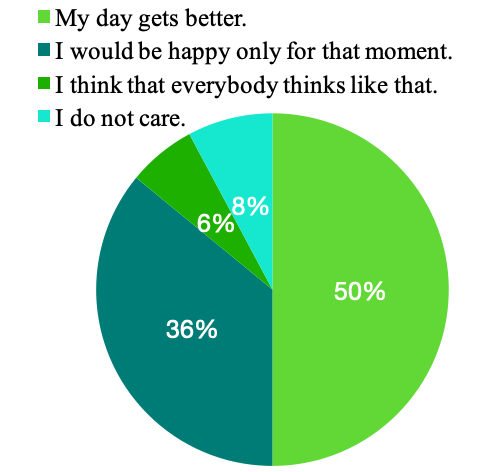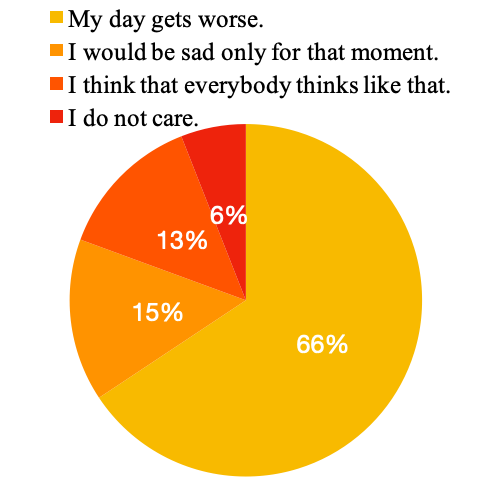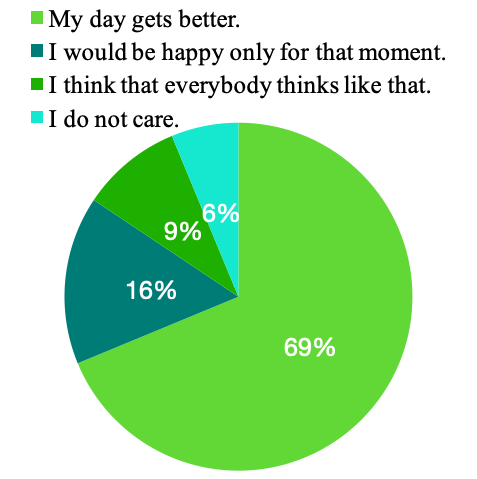The Sociocultural Influence on Female Turkish Residents in terms of Body Image
13 Aralık 2022Ayça Sezer Sezer
Many people are highly affected by other people’s thoughts and tend to shape their lives according to certain social expectations. Body dissatisfaction is a common result of the aim of fitting into society. Apart from positive body image, which is accepting one’s own body and appreciating its health, features, and the function of it (Tylka & Wood-Barcalow, 2015); body dissatisfaction can be defined as the negative sense, manners, beliefs, and sensations that a person maintains towards his or her body (Alharballeh & Dodeen, 2021; Neagu, 2015). Body dissatisfaction is a result of the ideal body image created by different societies. The ideal body image is mainly spread by sociocultural factors such as family, peers, and the media. Since Turkish girls between the ages of 14-20 are highly influenced by the spread of ideal body standards through sociocultural factors, they pursue unhealthy practices.
Literature Review
Researchers have investigated that people shape their lives in order to be accepted in the society that they live in (Atik & Örten, 2008). Those desires to be a perfect fit for society are prevalent in terms of body image. Even though body image is generally related to only females in society; males also struggle with this matter from a young age. Sociocultural factors such as peers, families, and the media play a crucial role in terms of spreading ideal body standards. This sociocultural pressure can push girls to pursue unhealthy practices (Stapleton et al., 2017; Rajagopalan & Sherjwal, 2014), besides feeling insufficient, insecure, and depressive (Olivardia, 2004). Age (Tatengelo & Ricciardelli, 2013; Rajagopalan & Sherjwal, 2014) and education level (Zhang, 2013) are some of the major determinants of the ways in which girls see themselves; since in some circumstances influence their mental development.
Body Dissatisfaction in Turkey
As the origins of Turks reach central Asia and the majority of Turkish people pursue Islamic practices as well as the fact that Turkey is in a geographical condition that is a bridge between the eastern and western worlds, it is a fact that Turkish culture is highly influenced by Eastern cultures (Sunar & Fişek, 2005). Even though the majority of the traditions rely on Eastern culture, due to the geographical condition of Turkey and the fact that Turkey is home to different ethnicities, Turkish cultural practices include modern and Western features (Sunar & Fişek, 2005). In Eastern cultures, the ideal body for women differs in the Middle East and Asia. While in the Middle East plump women are desirable, in Asia petite women fit the ideal body image. On the other hand, in Western culture being thin is desirable (Swami, 2015). With the westernisation of the media, and hosting different cultures, the ideal body in Turkey differs in different regions. But to identify in general, young people are highly influenced by the Western culture in terms of body image; in which they classify thinner as beautiful (Saraç & Aynacı, 2020).
Method
Participants
The participants were 63 volunteer girls whose age is between 14 and 20. The mean age for the girls was 16.92. They were either high school or undergraduate university students. All girls were living in Turkey and were raised in Turkish culture. Participants will participate voluntarily. The participants were given random names because of privacy.
Design
The participants are going to be found by using the snowball sampling method. The survey will be conducted online by using Google Forms, due to the Covid-19 pandemic. The survey includes multiple-choice and open-ended questions (see Appendix).
Results
In the survey, two major aspects of body image were investigated. The first aspect was how the thoughts of people affect the way girls feel about themselves. That aspect investigated the difference between the influence of inner circles’ and strangers’ thoughts. The second and last aspect is the effect of the media on girls’ ideal physical appearance, in which the focus was on celebrities, and how their lifestyles and body types influence girls.
To investigate the influence of different people’s thoughts, different questions regarding different distant people were asked. For instance, 3 of the girls who participated in this survey, indicated in the following questions that they would wish that they cared less what other people think. The influence of the thoughts of the inner circle is as follows:


Positive thoughts of the inner circle.
Negative thoughts of the inner circle.
On the other hand, with another question set, the influence of strangers’ thoughts was investigated. Conversely from the inner circle, girls tend to care less about the negative thoughts of strangers. Hence those strangers’ comments show an effect for less time compared to the inner circle. But when a negative comment is received from a stranger they think that everyone thinks that way. The influence of strangers’ thoughts was as follows:


Positive thoughts of strangers.
Negative thoughts of strangers.
The term “fit” was commonly used by several researchers (Atik & Örten, 2008; Tyler & Barcalow, 2015; Tatangelo & Ricciardelli, 2013); therefore, the meaning of “being fit” has been investigated. The way girls perceive the idea of being fit changes; while some of the girls stated that being fit is only “a perception”, others gave different answers:
Gökçe (16): “Small waist.”
Naz (14): “To be thinner than you should be.”
Fulya (16): “To have a 90-60-90 body.”
Oya (20): “To be in the ideal weight for your body.”
On the other hand, when asked, 66.7% of the participants stated that they do not think they are fit, which shows great body dissatisfaction among Turkish girls. It has been investigated that even though some girls indicated “being fit” in a social sense, they do not consider themselves fit.
When asked, what would they change about themselves if they could; the answers linked with the question about being fit, which showed that girls are experiencing great body dissatisfaction that in some contexts this dissatisfaction could change how they act:
Deniz (19): “A lot of things. My weight, skin problems, my eyes. Because I don’t feel comfortable, sometimes I feel like I have to hide. With the influence of the comments I receive and the things I hear about weight and also the things I see on the internet, weirdly I feel bad.”
Canan (14): “I want to be fit. Because I want my clothes to fit me just as beautiful as they fit on other people.”
Öykü (15): “My weight because I want to be healthier.”
Ecrin (15): ”My weight. Because I am fat.”
On the other hand, the same question showed that there is in some circumstances aging changes the way girls feel about themselves:
Berra (19): “If I would answer these questions when I was 14, there would be tons of things that I want to change in me.”
Gizem (20): “I used to have so many things in myself that I wanted to change, and I remembered after thinking about it for a while that even if I can change them I will want to change more things. No one is perfect, and it is really unnecessary to strive for perfection.”
Finally, the influence of celebrities via media was also investigated in the focus group were as following:
Question 12: Is there a celebrity that you wish to be him/her? If yes who?
Ayşe (19): “Alina Boz, because I like her physique.”
Özlem (19): “Madison Beer, because she is very beautiful and impeccable.”
Zeynep (20): “Hailey Bieber, because she is very beautiful.”
Canan (14): “Millie Bobby Brown, because she is rich, fit, beautiful and has 40M followers.”
Banu (16): “Hande Erçel, because I don’t know, I find her good.”
Discussion
With the limited literature about Turkish girls’ views on body image and body dissatisfaction, the main focus of this study was to examine how different Turkish girls pursue body image and how effective the sociocultural factors in terms of influencing girls to a specific body type are. In addition, the survey that has been conducted as the main source of this study might affect the girls. In fact, it might help them to question those ideals, and how healthy it is to follow many practices to reach one ideal body type. The survey allowed the girls to express their thoughts deeply since it was anonymous. Nevertheless, if the survey was conducted in a fully open-ended or face-to-face in a semi-structured form, the answers could reflect more of the real struggles of the girls.
Sociocultural Influences on Body Image
Sociocultural factors shape how people live to a large extent. The reason why those factors play a major role in people’s lives is that people want to be accepted in the society they live in (Atik & Örten, 2008). According to researchers, sociocultural expectations like weight loss are associated with women, whereas for men the ideal thing to do is to increase muscle mass (McCabe & Ricciardelli, 2001; Ricciardelli & Tategelo, 2013). Even from the stigma of women losing weight, as well as women, preadolescent boys are also influenced by this stigma from the females around them (Stanford & McCabe, 2005). Although sociocultural factors play a huge role in influencing people, Rajagopalan and Sherjwal (2014) found out that Indian women do not feel under pressure or influenced by social standards of beauty, but they are widely influenced by their peers’ and families’ thoughts, hence want to be thinner. On the other hand, from the evidence gathered from Questions 3, 4, 5, and 6 (see Appendix), it has been seen that Turkish girls are almost equally affected by the thoughts of strangers and the close people around them. Even though girls tend to ignore what strangers think about them, many of them are influenced by those strangers’ opinions. On the other hand, one 19-year-old stated that she is insecure about her weight because of the comments she receives from random people around her. However, the influence is a long-term influence when it is received from the inner circle.
Correspondingly, the media also shows a great influence on the spread of sociocultural factors among people. According to Park (2005), media plays a huge role in how women see themselves and besides that, media also influences the “thin ideal” and make everyone accept thinness as beauty. Similarly, Oğuz (2013) suggested that the media influences the idea of “thinness equals beauty” which contributes to dissatisfaction. Besides those influences, the media also shapes the thoughts of peers and families which has more effect than it does its own. As the data collected from the survey shows, girls want to have the lives that celebrities and more importantly they want those celebrities’ bodies. Movies and advertisements include women with the same type of body type and build the main story around the character that has the body which is looking most like the accepted ideal body type. Those advertisements and movies which help the idealisation of a certain body type, affect girls in a negative way in which since they link happiness with having that body type, they think that all of their problems are going to be solved if they would have that specific type of body.
The Relationship Between the Sociocultural Influence and Age
Researchers have found that age can be a major determinant for humans in terms of affection. According to Rajagopalan and Sherjwal (2014), Indian women who are around 19 are more likely to get affected by the thoughts of their families and peers rather than sociocultural expectations. On the other hand, researchers have discovered among university students in United Arab Empires that the results of different age groups do not show a significant change. Neagu (2015) suggested that body image dissatisfaction starts in childhood from sociocultural factors and besides them, toys play a great role in idealisation. It has been stated by Neagu that even though aging brings changes in human bodies, the affection from sociocultural factors researchers did not show a significant increase in terms of body dissatisfaction (2015). From the answers received from Question 10 in the survey (see Appendix), little influence has been investigated in the following answers: “If I would answer these questions when I was 14, there would be tons of things that I want to change in me. (19)” and “I used to have so many things in myself that I wanted to change, and I remembered after thinking about it for a while that even if I can change them I will want to change more things. No one is perfect, and it is really unnecessary to strive for perfection (20)”. Conversely from these answers that show an influence of age in the affection from sociocultural factors, other participants did not mention that they were less or more influenced depending on their age. Hence, the answers received from 14-year-olds and 19, 20-year-olds did not have a distinct difference. This shows, even though researchers have found a correlation between age and amount of influence since young people are more open to getting influenced by everything they see, there was little evidence supporting this in the survey that is conducted on Turkish girls.
Consequences of the Influence of “Ideal Body Image”
With this research and other research, it has been identified that sociocultural factors play a significant role in influencing girls to have the “ideal body”. The idealisation of only one body type could bring some consequences with it, as it could affect girls psychologically hence making them feel insufficient as well as insecure. According to the survey, a 19-year-old girl stated “I want to change my weight. Because I don’t feel comfortable, sometimes I feel like I have to hide”; on the other hand, another girl (19) stated that she wants to change her body because she has a pear-shaped body and one other girl wanted to change her body because she has a “big hips” and “thick waist”. These results show how those sociocultural factors make girls feel insecure about their bodies and make them want to change their bodies because of the way they look. Similarly, in the research that has been done by Rajagopalan and Sherjwal (2014), it has been investigated that the influencing can be toxic to the girls to a point that the only thing they feel is being insufficient no matter what they do. Which might lead to depression in long term (Olivardia et al., 2004).
As well as psychological problems, these unhealthy practices that girls pursue in order to have that specific body type can also cause physical health problems like unhealthy dietary and behavioural practices (Rajagopalan & Sherjwal, 2014). According to the research conducted by Stapleton et al. (2017), since tanned girls are considered more beautiful by societies, they pursue some unhealthy practices such as tanning in a way that is very dangerous to one’s skin in order to reach that ideal body; by these practices, the girls are getting physically harmed. Similarly, Oğuz (2013) suggested that according to the research due to the influence of the “thin ideal body”, 90% of the diseases related to an eating disorder are related to women. Diversely, in the survey that has been conducted on Turkish girls prior to this report, no significant evidence was found. However, it has been investigated that, 69.8% of the girls that conducted the survey, indicated that they want to change something physical in them. Of those 44 girls, 33.6% of them said that they want to change either their weight or their body type. On the other hand, the answers showed that they do not only consider being “thin” beautiful but include such features as confidence, intelligence, and personality. Even though none of the girls mentioned that she is practising unhealthy behaviours to reach the ideal for her; it is obvious from the answers that there is great body dissatisfaction among Turkish girls.
Conclusion and Further Research
As a conclusion, younger girls are more influenced by social pressure than older girls; due to inner-self-development. Additionally, Turkish girls are influenced long-term by their inner circle in terms of negative messages; but they are affected by the thoughts of strangers majorly. In order to minimise the pressure created by those sociocultural factors on the ideal body image, people need to be educated. Similar to what Zhang (2013) stated, with education, people are going to be aware of the consequences of this pressure, and how unreal for everyone to be in one size is. Also, with the help of education, self-love can be engrained in girls’ minds, because even though they reach those ideal body types, since they are not happy the way they are, the insufficiency will follow them. As Albertson, Neff & Dill-Shackleford (2015), found out with self-compassion training it is possible to make girls love themselves the way they are.
References
Albertson, E. R., Neff, K. D., & Dill-Shackleford, K. E. (2015). Self-compassion and body dissatisfaction in women: A randomized controlled trial of a brief meditation intervention. Mindfulness, 6(3), 444-454. https://doi.org/10.1007/s12671-014-0277-3
Alharballeh, S., & Dodeen, H. (2021). Prevalence of body image dissatisfaction among youth in the United Arab Emirates: Gender, age, and body mass index differences. Current Psychology, 1-10. https://doi.org/10.1007/s12144-021-01551-8
Atik, D., & Örten, T. (2008). İdeal beden imgesini oluşturan sosyal ve kurumsal faktörler ve bu idealin bireyler üzerindeki etkileri. Journal of Faculty of Letters / Edebiyat Fakültesi Dergisi, 25(1), 17-35. https://dergipark.org.tr/tr/pub/huefd/issue/41206/502694
McCabe, M.P., & Ricciardelli, L. A. (2001). The structure of the perceived sociocultural influences on body image and body change questionnaire. International Journal of Behavioral Medicine, 8(1), 19-41. https://doi.org/10.1207/S15327558IJBM0801_02
Neagu, A. & Rainer, F. I. (2015). Body image: A theoretical framework. The Publishing House of the Romanian Academy, Series B, 17(1), 29–38.
Olivardia, R., Pope, H. G., Borowiecki, J. J., & Cohane, G. H. (2004). Biceps and body image: The relationship between muscularity and self-esteem, depression, and eating disorder symptoms. Psychology of Men and Masculinity, 5(2), 112–120. https://doi.org/10.1037/1524-9220.5.2.112
Oğuz, G. (2013). Bir güzellik miti olarak incelik ve kadınlarla ilgili beden imgesinin televizyonda sunumu. Selçuk İletişim, 4(1), 31-37. https://dergipark.org.tr/tr/pub/josc/issue/19012/200789
Rajagopalan, J., & Shejwal, B. (2014). Influence of sociocultural pressures on body image dissatisfaction. Psychological Studies, 59(4), 357-364. https://doi.org/10.1007/s12646-014-0245-y
Park, S. Y. (2005). The influence of presumed media influence on women’s desire to be thin. Communication Research, 32(5), 594-614. https://doi.org/10.1177/009365020527935
Saraç, E., & Aynacı, G. (2020). Üniversitelerdeki genç kızlarda güzelliğin algılanması; Türkiye’de güzelliğin geniş kavramsallaştırılması. OPUS -International Journal of Society Research, 15(23), 1829-1848. https://dergipark.org.tr/en/download/article-file/1007463
Stanford, J. N., & McCabe, M. P. (2005). Sociocultural influences on adolescent boys’ body image and body change strategies. Body Image, 2(2), 105-113 https://doi.org/10.1016/j.bodyim.2005.03.002
Stapleton, J. L., Manne, S. L., Greene, K., Darabos, K., Carpenter, A., Hudson, S. V., & Coups, E. J. (2017). Sociocultural experiences, body image, and indoor tanning among young adult women. Journal of Health Psychology, 22(12), 1582-1590. https://doi.org/10.1177/1359105316631198
Sunar, D., & Fisek, G. (2005). Contemporary Turkish families. Families in global perspective, 169-183.
Swami, V. (2015). Cultural influences on body size ideals: Unpacking the impact of Westernization and Modernization. European Psychologist, 20(1), 44-51. https://doi.org/10.1027/1016-9040/a000150
Tatangelo, G. L., & Ricciardelli, L. A. (2013). A qualitative study of preadolescent boys’ and girls’ body image: Gendered ideals and sociocultural influences. Body Image, 10(4), 591–598. https://doi.org/10.1016/j.bodyim.2013.07.006
Tylka, T. L. & Wood-Barcalow, N. L. (2015). What is and what is not positive body image? Conceptual foundations and construct definition. Body Image, 14, 118-129. https://doi.org/10.1016/j.bodyim.2015.04.001
Zhang, K. C. (2013). What I look like: College women, body image and spirituality. Journal of Religion and Health, 52(4), 1240-1252. https://doi.org/10.1007/s10943-012-9566-0
Appendix
The Interview Questions
- How old are you?
- How often do you look at yourself in the mirror in a day?
- How do you feel when a person compliments you?
- How do you feel when someone close to you compliments you?
- Does something negative a person says to you about you change the way you see yourself?
- Does something negative someone close to you says about you change the way you see yourself?
- What does “being fit” mean to you?
- Do you think you are fit?
- What makes a woman beautiful?
- If you could change something in yourself, what would it be?
- Why?
- Is there a “celebrity” that you wish you be him/her? If yes, who?
- Why?
- How would you rank the women below from 1 to 9 from most beautiful to less beautiful?

